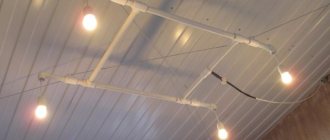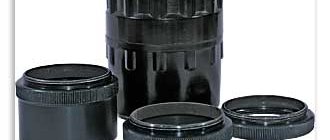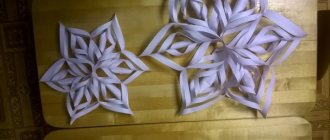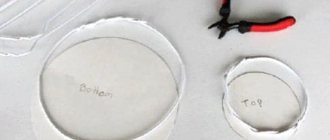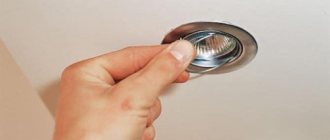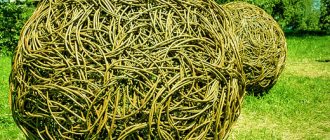In order not to waste time in winter, many home craftsmen and DIYers disappear into the workshops. For example, they assemble furniture or make decorative interior items. One of the successful options is an antique pendant chandelier made from a cart wheel.
Brutal wooden round chandelier with forging.
Do you want to get an analogue for an inexpensive price? Read the article, which describes in detail how to make a wheel chandelier with your own hands.
Preparation of a sketch and production of lamp parts
Diagram of a plywood lamp: 1,2,3 - bracket parts.
4,5,6 - details of the lampshade. For a beginner, it is best to choose model options with parts that are easier to implement. You can make an invented item yourself or choose a model you like from any source: a magazine, the Internet, etc. It is advisable to have sketches of each part and instructions for implementation. If instead of a sketch there is only a diagram, you first need to draw each detail in natural size on a sheet and cut it out, then attach them to each other and, if necessary, make adjustments, and only after that transfer the template drawing to a sheet of plywood. If you have minimal experience working with a jigsaw, it is better to choose models without a large number of openwork elements.
After all the parts have been transferred to the plywood, you can start cutting them out. The next stage is processing them with sandpaper, first coarser, then fine, and finally, to ensure the smoothest possible surface, “zero”. After this, each part can be coated with colorless varnish or paint.
It is important to take into account the fact that the surface may “heave” - then you need to go over the painted layer again with sandpaper, and then apply one or two more, depending on the required color intensity, layer of paint or varnish
Related article: How to make roller blinds with your own hands
Key holder for the hallway
An interesting option for DIY work is a key holder craft, cut out of plywood with a jigsaw. This product not only has a beautiful design, but also serves a practical role. The keys will always be in a visible place, preventing the risk of losing a key in the apartment. To work, you will need a sheet of plywood, a set of metal hooks, compositions for impregnating the accessory, and compositions for decoration. Mounting hardware and hooks can be purchased at any hardware store. Drawings for simple plywood crafts can always be found in the public domain.
Instructions for operation:
- Preliminary markings are made on a sheet of plywood, drawing the outline of any selected shape. Modern key holders can look like a clock, a house, an open book or another artistic image.
- Using a jigsaw, cut out the base image strictly along the contour.
- The key holder may have additional sides. If they are provided for by the selected product model, you should also cut out parts for the sides.
- Measure the diameter of the purchased hooks.
- Several holes are made in the main panel using an awl or other sharp tool.
- Next, they impregnate the future key holder with special compounds.
- The plywood base is decorated (painting, opening with acrylic varnish, wood burning or decorative carving).
The hooks are mounted by inserting them into the prepared holes. On the reverse side, fastenings to the underlying wall are made.
How to make a wall lamp from plywood?
Correct design lies not only in the proper placement of furniture, but also in the correct lighting of the space; this can be helped by making sconces from plywood yourself; such lamps are suitable for any interior and will add a special atmosphere to the room when the overhead lighting is turned off.
There are many options for making wall lamps, which can affect the appearance of the room in different ways:
- the use of unnecessary things in addition to wood in the structure, for example, connecting parts of a water pump and a wooden structure;
- The original lamp is made from a single piece of wood with wood selected from the inside and colored glass elements.
Wall lamp from sticks Instructions on how to easily make a wall lamp (sconce) from sticks:
- you need to take a board and give it the desired shape, attach a hook to it;
- we make a lamp from sticks of the same length, assembled in the form of a well;
- we assemble an electrical circuit, a socket and an LED lamp, we route the wire through a decorative holder that is attached to a hook, the result is an almost fairy-tale sconce lamp.
Cover fastening
Now you need to attach the cover to the almost finished lantern. There is another aspect here: you need to decide on the location of the light bulb socket in the lantern. If you decide that the light bulb will be screwed with the base into the bottom, then before fixing the lid, you need to place and fix the socket in the glass by running a pair of wires, cleared of the first layer of insulation, along the inner corner of the “glass”. This method is more complex in terms of switching due to the wiring being routed outside the lamp through the entire structure.
Taking all these points into account, you decide that it would be better to place the cartridge specifically under the cover. We proceed as follows: in the lid, exactly in the center, we drill a hole into which we can insert the straight end of the screw-hook and thread the ends of the wires. We disassemble the cartridge and attach the wires threaded through the cover to the contact pair.
Tip: in order not to strain yourself with unnecessary operations to fix the cartridge to the lid, you can insert a hook screw into the cartridge cap and tighten it with a nut suitable for the thread. As a result, you will get a combined lid with a cartridge. For greater reliability, heat-resistant glue can be applied to the contact area of the parts.
All that remains is to make the lid movable. To do this, we place the lid on the lantern so that its edges protrude moderately, and mark on the two reverse faces on the inside of the “pyramid” with a narrow line the place of their contact with the walls of the lantern. Instead of a loop, it is better to use a piece of fabric equal to half the length of the upper side of the wall of the “glass” of the lantern and such a width that it is not visible through the sawn outline.
We first glue half of the fabric, split lengthwise at the thought level, to the lid, without going beyond the previously marked line. To the reverse side, along the marked strip, glue a piece of nylon thread, pulling it very tight. Let it dry and glue the remaining part of the “loop” to the wall of the lantern from the inside. In the wall of the lantern, above which the nylon thread was glued, on the front side, screw a small screw as high as possible or drive a shoe nail.
Tip: The fabric must be glued without stretching it - so that there is a gap of 3-4 mm. This will prevent the fabric from coming off when opening the lid, immediately pressing it tightly against the lantern when closed.
Using an old power supply for a night light
Nowadays, so many mobile phones pass through the hands of each family member that you can easily find a couple of different chargers. You can make an LED night light out of them with your own hands. This circuit will be much better than a capacitor circuit:
- Ready-made housing with plug for connection to the network;
- galvanic isolation from the network - there will be no high-voltage potential at the capacitor terminals;
- stabilized values of output voltage and current.
Underwater rocks
A story from practice: the manufacturer indicates on the charger body an output voltage of 5V and a current of 1A (may differ). When I made a night light for myself, I calculated the resistors for the LEDs for this voltage. The night light practically stopped shining after 2 nights. The LEDs dimmed, and the lampshade of the night light was always warm...
In addition, I initially, by mistake, soldered in resistors with a value slightly less than the required 100 Ohm. I became interested in why the LEDs were degrading and I measured the voltage. The charger gave out as much as 7 and a penny volts. Naturally, the LEDs were fed with twice the rated current.
Moral: do not believe what is written, but check the voltage and current of the LEDs with a multimeter.
Look at the diagram of an LED night light from a mobile charger.
To correctly assemble the circuit, select resistors that match the voltage of your charger and LEDs; learn more about how to select a resistor. But be careful and do not repeat the mistakes of others, an incorrectly set current will kill the LED.
As a result, you can get a similar LED night light. If desired, you can hide the diodes with a diffuser from a broken LED lamp.
More details on how to make a night light from LEDs and a smartphone charger are described in the video.
Many phones come with chargers with a USB connector. You can buy ready-made LED modules in USB flash drive format and get a simple LED night light. True, you will not get pleasure from designing, developing and assembling a custom night light.
A night light is the simplest and most harmless device that you can make with your own hands. On the other hand, its simplicity and lack of requirements for brightness make it possible to turn a simple and ordinary thing into a real work of art.
At the same time, you can implement many ideas, such as iridescent colors on an RGB strip, or turning on a night light when there is a clap or depending on the light level. Look at the LED acoustic switch diagram.
The circuit is quite interesting to build. As a microphone, a microphone from a mobile phone or computer headset is suitable; common Soviet transistors - KT315G reverse conduction, and KT3107B - direct conduction, can be replaced with any analogues.
Resistor R3 sets the operating point of the transistor and, accordingly, the sensitivity of the circuit
Transistor VT2 is the second stage of the amplifier, and capacitor C2 is electrolytic, pay attention to this
Please rate the article. We tried our best:)
How to make a night light from a jar
One of the materials for creating decor in the house is a tin can. How to make a night light from a jar, read on:
For this you will need:
- ordinary tin can;
- long nail;
- paint (blue, purple, black);
- base with lamp.
Algorithm of actions:
- Wash the tin thoroughly to remove all excess, including the label.
- Using a nail, we make holes on the can and on its sides; you can either scatter them or form a pattern of dots.
- We paint the jar, for example, dark blue, because... it is associated with the sky.
- We fix the base with the lamp in the jar.
- The night light for the nursery is ready.
In complete darkness, such a lamp will look chic.
Casket
The box is a lightweight version of previous creations. However, it is not without patterns, and is sometimes even presented in an oval form. It is better to start with a rectangular model, because... its production does not require complex decisions:
- First, a drawing of the craft is drawn;
- Next, four walls, a bottom and a lid are cut out of a sheet of plywood;
- The next stage is to cut holes in the walls and lid (optional, but desirable)
- Next, the edges of all elements are smoothed using a grinding machine;
- The final step is to fasten the walls to each other, after which comes the fastening of the bottom and lid to the walls, respectively.
Moreover, to attach the lid you will have to purchase decorative canopies. The walls are fastened to each other and the lid to the walls using the tongue-and-groove method or using screws.
The finished box, like light crafts made from plywood, welcomes painting and other decorative designs, which will be discussed a little later.
How to make a chandelier with your own hands from thread tassels and hoops
CBC Life YouTube channel
What do you need
- Yarn;
- small photo frame;
- scissors;
- 3 sets of wooden hoops of different diameters;
- 3 identical short and 1 long metal chains;
- pliers;
- bulb;
- lamp pendant.
How to do
1. Wrap the yarn around the photo frame many times and cut. Take a small piece of thread and tie it on top of the yarn so that the ends remain. Cut the threads on one side, where the frame hole is located.
CBC Life YouTube channel
2. Remove the yarn from the frame and fold it in half. Place the knotted thread in the middle so that its ends are at the bottom and the loop is at the top. Details are in the video below. Cut another piece of thread and use it to tie a tassel just below the loop.
CBC Life YouTube channel
3. Make the rest of the tassels in the same way. The quantity depends on the diameter of the hoop. The threads should frame them tightly.
CBC Life YouTube channel
4. Remove the center hoops from all hoops - you won't need them. Open the large hoop and put some of the tassels on them by the loops.
CBC Life YouTube channel
5. Close the large hoop. Place the tassels on the rest in the same way.
CBC Life YouTube channel
6. Make nine pieces of thread. Place the middle hoop into the large one and tie them in three places at the same distance from each other.
CBC Life YouTube channel
7. Place a small hoop inside and tie it to the middle one in three places. These threads should be located approximately in the middle between those that connect the large and medium ones.
CBC Life YouTube channel
8. Turn the design over and straighten the tassels. Tie short chains to a large hoop at equal distances from each other.
CBC Life YouTube channel
9. Use pliers to open the end link of the long chain. Place the attached chains on it and close it.
CBC Life YouTube channel
10. Attach the pendant to the ceiling, screw in the light bulb and thread the lampshade through the bottom. A long chain can be hung, for example, on a hook mounted on the ceiling next to the base of the chandelier.
What other options are there?
There is another way to mount a chandelier. Place a metal ring on the lamp hanger and attach chains tied to the hoop to it. The detailed process is shown in the video below. By the way, the technology for making brushes in it is slightly different. And the author does not use a hoop, but metal hoops.
The tips of the brushes can be painted in a contrasting color:
Or make a gradient chandelier from colored threads, like here:
Pythagorean trousers
Let's move on to preparing the bottom and cover of the lighting fixture. Here you should decide on the final shape of the craft - whether its upper and lower parts will be identically pointed, flat, or different. You will have to get into the engineer's shirt and calculate some of the nuances of attaching the lamp socket and hanging the lighting fixture. A flat bottom and lid are easier to make than a four-sided “lid.” But if you make beautiful cutouts in a flat day that are in harmony with the rest of the composition (and there is no other way - you want your neighbors to simply wither with envy!), then the cartridge will be perfectly visible through them - and this is no longer in keeping with at first, the intended theme of the “Gothic” style. Therefore, let's focus on the “pyramidal” lid and day. The whole difficulty lies in correctly calculating the sizes and therefore at the moment, within 5 minutes, we will kill two “hares” at once: the first one - suitable for us and matching with its valuable fur to an unfinished fur coat, and the second - an old one, completely useless, at times floating together with memoirs about school times. We will talk about geometric calculations.
Let's turn to the school curriculum on geometry for the 6th grade, or more precisely, let's remember the Pythagorean axiom. She says: in a right triangle, the sum of the squares of the legs is equal to the square of the hypotenuse. But the cones of the lid and bottom that we have conceived have, well, nothing like right-angled triangles on their faces - which side can we “screw” the axiom of the great mathematician here?
It's simple! First, decide how tall the “pyramids” of the lid and bottom will be. In other words, how far will they protrude from the main frame of the lantern? To do this, take a “glass”, turn it towards you with any sawn side, attach a ruler to the back side and estimate the height of the future pyramid by eye. Let's give this value the value h. Then you’ll have to think a little or use my experience.
We need to calculate one side of the pyramid.
Let us denote the length of the end side of the frame (also the side of the base of the lantern/lighting fixture pyramid) as 2a. Let's call the height lowered from the top of the pyramid's face d. It turns out that we need to calculate the sides of a right triangle with the apex coinciding with the top of the pyramid, which seems to be located in the cross section of half the pyramid if we cut it from the middle of the first base to the middle of the other. Having legs equal to a and h, we calculate:
Advantages and disadvantages
The undeniable advantages of wooden lamps: • environmentally friendly raw materials, the product is absolutely hypoallergenic; • ease of processing and installation; • presentable colorful design; • high strength. Among the disadvantages: the flammability of the material, the need for certain temperature conditions and humidity parameters, and the possibility of damage by insects.
To avoid the effects of negative factors, the product is coated with a special composition. Impregnated with the necessary substances, the tree is not subject to delamination, ignition, deformation and damage by insects.
Tip: it is better to use LED or energy-saving lamps, as they heat up less during operation.
The best option for a wooden lamp in the interior is a living room or bedroom. In rooms with high humidity (kitchen or bathroom), it is still better to use appliances made of other materials. Wooden products in a damp room require more careful care, but still lose their former luster over time. When exposed to moisture, the material may shrink or swell.
Carpenter's trick
You already have in your hands a real lantern/lighting device made of wood, but without a cover and with ugly edges. The time has come to “liquidate” them. Let's return to those sawdust that I asked you not to throw away, guaranteeing that they will still be useful. With their help and ordinary PVA glue we make grout (although it can be replaced with wood putty sold in the store, but that’s not interesting).
Take any cup without worrying that you will have to throw it away - the prepared mixture is simply washed off. Pour sawdust into it and, stirring with a spatula, begin adding glue. Your goal is a paste with a viscosity similar to mashed potatoes. Did it work out? Don’t hesitate - it dries quite quickly due to the absorbent properties of sawdust. You need to practically rub this mixture into all the outer seams of the “glass” and “pyramids”. After drying, all you have to do is sand the corners. If you do everything correctly, then the thing you get will create a memory of solidity, in other words, it will seem that it was cut out of a single piece of wood.
We should not forget about the vagaries of the weather and its brutal humidity towards wood products. Even in indoor conditions, treated wood remains at risk of swelling and loss of shape. To avoid this, simply treat all parts with a moisture-protecting agent, following the instructions from the manufacturer.
Outdoor materials
The choice depends on the owners, since different materials can be used for street lamps, the main thing is that they are not afraid of water. Popular plastic falls into this category, but it has one big drawback - fragility. For this reason, it is not the best solution, since sooner or later such a flashlight will definitely break.
Metal is the ideal material
The best option is to make a street lamp from metal. And here there are three worthy candidates: bronze, brass, copper. However, the first alloy will constantly darken, so the owners will have to sacrifice time cleaning the lantern. Copper will oxidize over time, and such a lamp will acquire an unsightly greenish tint.
Candidate materials at hand
It is not always possible (and passionate desire) to make something designed to last forever. For example, in summer cottages it is more logical to build a structure from a simple material that does not require serious processing. Therefore, the owners, whose “bins” are full of all sorts of goods that are a pity to throw away, make street lamps from any raw material. Suitable for this:
- jars: tin or glass;
- clay;
- wood (for example, twigs, wood chips);
- cardboard boxes (requiring good moisture protection);
- plastic containers;
- old dishes;
- building materials;
- PVC pipes.
Such street lamps have a great advantage: they almost always attract attention, as they turn out to be unusual and original. Another plus is the ease of their manufacture, because their creation does not require a welding machine or a lot of time
Yes, there is a minus - it is fragility, but to replace the old product, you can easily and quickly build a new one, but already having a completely different - “fresh” - look.
DIY wooden masterpieces
To assemble a wooden chandelier with your own hands, experience with wood will not be enough. You will also need basic electrical knowledge. You can take a ready-made wooden model as a basis or develop your own original design.
Depending on your skills in handling metal, choose an exclusively wooden lamp or a lighting device supplemented with metal elements. The photo gallery will once again demonstrate the possible options for making a wooden chandelier with your own hands.
May be interesting Curtains for curtains under a suspended ceiling: photos, which ones are better, types, how to hang them on a hidden structure
Wooden chandeliers are a stylish interior element that is suitable not only for rustic design trends with a national flavor, but also for modern room design ideas. Country and chalet, Scandinavian and eco style, modern and loft - for each style you can choose a successful model of a wooden lamp.
Choosing a lamp for a homemade chandelier
To make a chandelier made by you from scrap materials look even more attractive, you need to choose the right light bulbs for it. The following recommendations will help you:
Choose a lamp of suitable power. Remember that overly powerful products can cause a fire. Look at the number of lumens. The larger it is, the more natural the lighting. Consider whether the shape of the light bulb matches your device. Some chandelier models require bulbs of a strictly defined shape. Only then will they work efficiently and correctly reflect light rays. Be sure to look at the expiration date. If you plan to use the lamp frequently, then take a closer look at the lamps with the longest life expectancy. Ask what kind of light the lamp will glow - cold or warm. For your home, it is better to purchase an option with a warm shade of light.
This will make the atmosphere seem more comfortable. Don't ignore the energy consumption of a light bulb. Products with low energy consumption are considered the best choice. Check for the presence of mercury in the lamp - this determines how it is disposed of
Products containing mercury cannot simply be thrown into the trash. They must be handed over to special collection points.
What lamps to use
Conventional incandescent lamps get very hot and are therefore not suitable for installation in wooden chandeliers, the same applies to halogen lamps. Instead, it is better to use LED, fluorescent light sources.
How to choose a tree
Almost any available species is suitable as a material for making a wooden chandelier. The main condition is that the material is dry
Pay attention to signs of rot, mold and signs of vermin.
Let us describe the properties of the most commonly used rocks:
- Pine blanks lend themselves well to processing. The tree circles are separated by resin, so it is not used for making small parts.
- Cedar is famous for its beautiful pink base. The wood has a high density, so it can be used to make small jewelry.
- Hardwoods are stronger than pine and do not rot.
- Oak has a high density, but splits easily. It's difficult to process. It should not be used as a material for a lamp by novice craftsmen.
General rules
There are a huge number of ideas for all kinds of lampshades, chandeliers made from branches, driftwood, and boards. In general, the process of making a chandelier comes down to making a frame, providing wire connections for sockets and elements for fixing the product to the ceiling.
To make the wires invisible, you can make grooves in the wood. Secure the wiring with special plastic ties or staples. If it is invisible from the outside, then there is no need to make grooves. Sometimes the wires are left completely visible - this is a design decision.
Wood must be used without rot or wormholes. If you find some branch or snag in the forest, then inspect it; perhaps it has begun to rot and collapse. This type of wood is completely unsuitable for a chandelier, unless it can be trimmed.
Some people are interested in how to make a beautiful chandelier from driftwood. One idea is this. The driftwood must first be cleaned, peel off the bark if there is any, cut off all excess, and sand the surface. It is best to use such a figured tree for a lamp stand. If you want to make a chandelier, you can hang a piece of driftwood on chains from the ceiling and run a wire to it, threading it through the links. In this design, hollow cylinders can be cut out of wood for cartridges.
You should not pile up a lot of branches, as this will make the chandelier heavier. In addition, such a product does not always look harmonious. A large volume chandelier is better suited for spacious rooms, while in a regular kitchen small lampshades will look more impressive.
Manufacturing stages
First of all, you need to decide on the type and size of the product. You can think about the project yourself, you can use a ready-made one, or you can spy on an idea and take it as a basis, finishing and improving it. The step-by-step manufacturing steps are as follows:
- Templates of parts are drawn on a sheet of cardboard. They are made to full scale and cut out with a utility knife or scissors.
- Cardboard mock-ups of parts are placed on a sheet of plywood and outlined with a pencil. It is necessary to place them so as to use the material as economically as possible. If the patterns are large, then they can be fixed to the sheet with tape so that they do not move.
- Using a jigsaw, cut out parts from plywood along the contour. For ease of use, the sheet can be secured with clamps on the edge of the table. Small parts are cut out by hand. If you need to make holes in the middle, then first drill a hole large enough for the edge of the jigsaw to fit in, and then cut out the pattern.
- After the parts are cut, they are sanded with sandpaper until the surface is smooth. First you need to use coarse-grained paper, and finally sand with fine-grained paper.
- When all the elements are prepared, they are fastened together according to the project. You will need glue here.
- The finished product is varnished.
- A socket is installed inside the lampshade, connected to the electrical wire and the lamp is screwed in.
That's it, the lamp is ready! Since this is painstaking work and requires great precision and perseverance, you can first practice on small floor lamps, and only then start making ceiling chandeliers.
Plywood lamps can be an excellent interior decoration. If you gradually improve your skills and move from simple lampshades to more complex openwork lamps, you can hang them not only at home, but also delight your friends with an original element of interior decoration.
Gift ideas
After you have mastered the basics of cutting wood with a jigsaw, you can always amaze your loved ones with an unusual and unique gift, for example, a keychain for a bunch of keys or a case for a mobile phone. For such work, it is best to use plywood with a width of 5 mm and above. This can be either the obvious heart-star-man or the initials of the owner and even the full name! A name or initials can look like a solid composition, in which any subsequent letter seems to peek out from behind the previous one.
Also, each letter can be cut out separately with a jigsaw, and then fastened with glue in the correct order or randomly - even if it is not immediately clear what is written there
